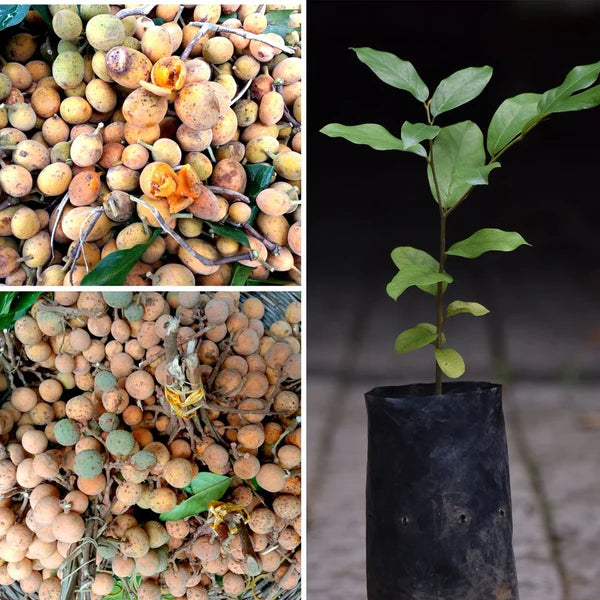Love it? Add to your wishlist
Your favorites, all in one place. Shop quickly and easily with the wishlist feature!
[message]
[title]
[message]
Veliyath Gardens
Couldn't load pickup availability
In the realm of lesser-known tropical fruit treasures, the Preah Dak stands as a quietly revered gem, cherished in its native Cambodia and gradually earning admiration across borders. With a sweetness that surprises and a cultural legacy rooted in centuries of local use, this rare fruit offers not just taste but tradition. Known by its local name “Preah Dak,” the fruit remains largely undiscovered outside its native region, making it a prized addition for collectors and tropical plant enthusiasts.
The Preah Dak fruit, while still waiting for formal classification in global horticultural literature, is well-known in Cambodian communities and surrounding regions. Its botanical identity remains somewhat obscure due to limited global cultivation and documentation, but it is affectionately referred to as Preah Dak in Cambodia—a name that pays homage to the fertile region of the same name in Siem Reap Province. In parts of neighboring Thailand and Laos, the fruit may be referred to under local dialect names with similar reverence, often linked to its sweetness and unique seasonal harvest.
For generations, Preah Dak has been more than just a fruit; it’s a seasonal celebration. In rural Cambodian households, the ripening of Preah Dak is associated with joy, family gatherings, and community bonding. The fruit is often gathered by hand in the early mornings, sold in bustling local markets, or shared among neighbors. In traditional herbal practices, some communities also regard the fruit as a soothing remedy for heat-induced fatigue and mild dehydration due to its juicy, hydrating nature.
The ripe fruit is a burst of tropical indulgence. It is consumed raw, often fresh off the tree, and is described as having an intensely sweet, juicy pulp with a slight floral undertone. The flesh melts on the tongue, making it a favorite for children and elders alike. In Cambodia, it is sometimes added to local desserts or fermented lightly into sweet preserves. Due to its naturally high sugar content, Preah Dak is often considered a healthy alternative to processed sweets and is perfect as a midday snack or a refreshing finish to a tropical meal.
Despite its unassuming appearance, Preah Dak fruit is rich in health-boosting components:
Natural Sugars and Energy: The high content of fructose and glucose makes it a natural energy booster, ideal for those needing quick refreshment.
Hydration Support: The fruit's juicy texture provides natural hydration, especially beneficial in hot climates.
Antioxidants: Preliminary studies and traditional claims suggest the fruit contains bioactive compounds that help reduce oxidative stress.
Digestive Aid: The fiber content supports healthy digestion and contributes to gut health.
Immunity Booster: Regular intake during seasonal availability is believed to support immune function, especially when consumed fresh.
While the fruit is commonly harvested from the wild in Cambodia, efforts to cultivate it in home gardens have been increasingly successful. The plant's adaptability and resilience make it suitable for tropical and subtropical climates.
Soil Needs: Thrives in well-drained, moderately rich soil with good organic content.
Sunlight: Prefers full sun but can tolerate partial shade.
Watering: Requires regular watering during dry seasons; however, it has moderate drought tolerance once established.
Propagation: Typically grown from seeds. Seedlings respond well to gentle care and organic fertilizers.
Growth Habit: The plant grows as a small to medium-sized tree or shrub, depending on the environment, with a manageable canopy and seasonal fruiting.
The Preah Dak plant is low-maintenance, requiring occasional pruning to maintain shape and improve airflow. Pest resistance is relatively high, and it rarely succumbs to disease if grown in well-ventilated areas. It’s suitable for both novice gardeners and experienced growers looking to expand their collection of tropical rarities.
The fruit is best consumed fresh due to its delicate, juicy texture. However, it can be preserved by refrigeration for a few days. In Cambodian households, the fruit is sometimes sun-dried or turned into syrups and sweet pastes for use in traditional sweets and snacks. Preservation in light sugar syrup is also common, maintaining flavor while extending shelf life.
Bringing home a Preah Dak fruit plant is more than just an act of gardening—it is an entry into a cultural experience. Imagine stepping into your garden and tasting a fruit that has nourished and delighted Cambodian communities for centuries. The sweetness lingers, the joy deepens, and the connection to a living tradition takes root right in your backyard.
Preah Dak is not just for eating—it’s a conversation piece, a symbol of biodiversity, and a thoughtful choice for those who value sustainability and heritage in their gardens.
Veliyath Gardens is proud to introduce this rare, native Cambodian fruit plant to tropical plant enthusiasts in India and beyond. As one of the few exotic fruit nurseries offering this unique species, we ensure that each plant is carefully nurtured for optimal growth in your garden.
Whether you are expanding your tropical fruit garden or seeking an extraordinary plant to deepen your connection to global cultures, the Preah Dak fruit plant is a worthy and soulful addition.
Let this Cambodian treasure grow in your space—bringing with it sweetness, stories, and a rich tradition of health and heritage.
Soil Needs: Thrives in well-drained, moderately rich soil with good organic content.
Sunlight: Prefers full sun but can tolerate partial shade.
Watering: Requires regular watering during dry seasons; however, it has moderate drought tolerance once established.
Natural Sugars and Energy: The high content of fructose and glucose makes it a natural energy booster, ideal for those needing quick refreshment.
Hydration Support: The fruit's juicy texture provides natural hydration, especially beneficial in hot climates.
Antioxidants: Preliminary studies and traditional claims suggest the fruit contains bioactive compounds that help reduce oxidative stress.
Bringing home a Preah Dak fruit plant is more than just an act of gardening—it is an entry into a cultural experience. Imagine stepping into your garden and tasting a fruit that has nourished and delighted Cambodian communities for centuries. The sweetness lingers, the joy deepens, and the connection to a living tradition takes root right in your backyard.

